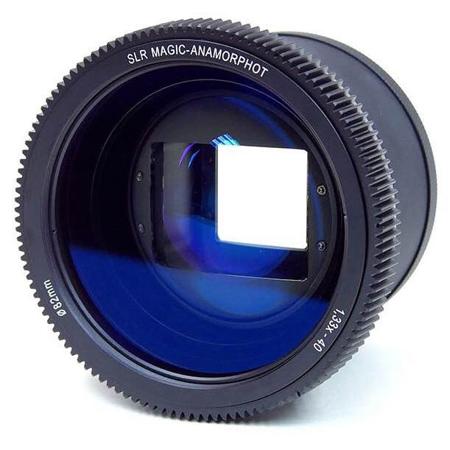


Review Summary
2017-12-26T07:47:04
I am really liking this adaptor. Does the anamorphic compression of 1.33 and is very easy to use with the lenses you already have instead of buying the real expensive anamorphic one from SLR Magic which goes for $ (cheapest on this kind). Only drawback is that you need to be careful on chromatic aberration and a softer image. It definitely does the anamorphic look on a budget. Great overall product and easier to use than others.
MARTIN B.
2017-08-23T12:13:04
Using this with an SLR Magic Cine III 25mm, and I love it. It's super easy to use. I've gotten some really awesome, cinematic shots. I haven't had the vignetting that some people mentioned about this lens, but it could also be the pairing with the first lens.
George S.
2017-06-04T15:28:11
I use this with two old Nikon lenses: Nikkor 50mm f/1.8 and Nikkor 35mm f/2.8 on a Sony FS5. I use an Atomos Shogun Inferno and am able to desqueeze. The built in focus ring is amazing, it allows me to set the taking lens and never have to touch it. Also having the geared ring to work with a follow-focus is a great addition. Highly recommended!
Taylor M.
Wonderful Anamorphic Solution for Low-Budget Filmmakers
By Taylor M.
I use this with two old Nikon lenses: Nikkor 50mm f/1.8 and Nikkor 35mm f/2.8 on a Sony FS5. I use an Atomos Shogun Inferno and am able to desqueeze. The built in focus ring is amazing, it allows me to set the taking lens and never have to touch it. Also having the geared ring to work with a follow-focus is a great addition. Highly recommended!
Lens flares for days, but also a very high quality lens.
By George S.
Using this with an SLR Magic Cine III 25mm, and I love it. It's super easy to use. I've gotten some really awesome, cinematic shots. I haven't had the vignetting that some people mentioned about this lens, but it could also be the pairing with the first lens.
Many indie filmmakers who wanted to shoot anamorphic had to depend on rare vintage lenses, which was not always reliable. In hopes to provide a reliable and available solution for indie anamorphic shooters, SLR Magic introduced the SLR Magic Anamorphot 1.33x-50 and 2x-50 adapter. These two adapters offered maximum compatibility for third party taking lenses.
The new SLR Magic Anamorphot 1.33x 40 adapter is a single focus anamorphic adapter designed to work specifically with the SLR Magic HyperPrime CINE 25mm T0.95 III at 2.8 on micro four thirds and the SLR Magic 50mm F1.1 CINE at 2.8 for E-mount S35 and APS-C sensor.
To achieve the much loved 2.35:1 scope aspect ratio, which gives a very pleasant, epic effect, filmmakers must crop off the top and bottom of standard 16:9 footage when using spherical lenses with modern digital cameras. As a result, 25% of sensor/negative information is discarded.
As a commitment to the film industry, SLR Magic developed this 1.33x anamorphic adapter to help filmmakers maximize their image quality by preventing this loss of vertical resolution. The unique 1.33x squeeze factor uses the entire 16:9 sensor/negative area to achieve the desired 2.35:1 aspect ratio.The Anamorphot 1.33x 50 does this by compressing a 33% wider field of view to fit the width of the 16:9 sensor/negative without compressing image height.
Modern professional cinema cameras have large sensors capable of capturing an image in the 2.35:1 format directly, using spherical lenses, but film makers still desire the anamorphic "look" which often limits them to using rare vintagelenses. These present a number of difficulties in practice such as size, weight, lack of close focus, availability, and high price. SLR Magic sought to overcome such issues with the SLR Magic Anamorphot.
The SLR Magic Anamorphot 1.33x 40 create a unique "artifact" such as horizontal lens flare, commonly referred to as anamorphic streaks, and may create slightly elongated bokeh when achromatic diopters are used. Over the history of cinema, these same stylish effects have contributed to the cinematic "look" of epic motion picture photography. Characteristics that shape this anamorphic "look" come from "front-mounted" anamorphic adapter designs such as the SLR Magic Anamorphot while "rear-mounted" anamorphic designs have more suppressed anamorphic characteristics.